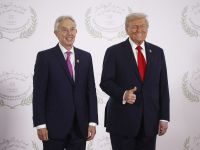The eight per cent surge in the dollar against the Japanese yen since mid July demonstrates that the world currency market has priced in US economic acceleration, a relative rise in the US Treasury and JGB interest rates spread at a time of Fed taper and Bank of Japan monetary easing. The higher dollar also coincides with softness in Chinese industrial production, a disaster for commodities dependent emerging markets. The collapse of the euro was entirely predictable once the Bundesbank dropped its hard money stance on the ECB and Russian sanctions/the Ukraine now began to hit German business confidence, GDP growth and exports. This was the reason I wrote several columns strongly recommending readers short the euro at 1.3650. Since the euro is 57 per cent of the US Dollar Index, a collapse in the euro meant king dollar surged from 79 in July (on the USD Index) to 85 now, a four year peak.
This seismic financial macro event has huge implications for the Gulf’s equity, property markets and liquidity engines, now that Brent crude has fallen $20 a barrel in the past three months. As in late 1998, or 2009, the surge in the US dollar is a huge deflation shock to the Gulf’s pegged currencies and its impact will be a major, even catastrophic fall in overleveraged, overhyped, overvalued regional asset markets. Flippers beware, you have nothing to lose but your Ferraris (if lucky) and your freedom (if unlucky).
The end of the Fed taper in October also coincides with a rise in the Volatility Index (VIX), Wall Street’s classic pendulum of greed and fear. The VIX has risen 25 per cent this week, one reason why the global equities index had a nervous breakdown. My investment strategy column last week was titled “storm clouds over Asia” and the US dollar’s surge and volatility spike wrecked havoc in Asian markets, from Mumbai to Hong Kong. I had also warned investors against funding currencies last week. Note the Indian rupee at 61.50. This time the wolf is here as the US dollar rally is in its early stage. If the euro drops to 1.10, as I expect, if the Bank of Japan’s two per cent inflation targets and the success of Abenomics after two lost decades means 160 yen (as I expect), why cannot NRI investors envisage a world where the Indian rupee trades at 75 against the dollar? I remember my Indian friends were shocked when I published successive columns recommending shorting the Indian rupee at 45–46 in July 2011. Two years later, the Indian rupee was down almost 50 per cent since my recommended short. Emerging market credit cycles are brutal at inflection points.
Gulf investors must remember that the decade of easy money and zero interest rates in the US is coming to an end. The monetary regime in the Gulf will shadow US dollar rates, due to currency pegs and speculative capital flows. We are entering the world of king dollar, last seen under President Reagan (1981-85) and Clinton (1995-1999). Note that both periods of secular dollar rallies coincided with oil crises, banking collapses and property crashes in the Gulf. Why? The logic of credit cycles and the global transmission of deflation risk via pegged currency systems.
The US shale oil revolution and Asia’s nervousness over the rise of China as well as the new West-Russian conflict in Europe will lead to a tsunami of capital flows to America’s banking system, the world’s safest after the debacles of the 2007-08 credit bubble. As long as the US grows while Europe slips into recession and China slows, king dollar will reign supreme.
The euro has lost its claim as a potential reserve currency. The Chinese renminbi’s value is managed by the Politburo. Japan has no real offshore market for yen denominated government bonds. The Indian rupee lost its chance to become a global currency at the Battle of Plassey. The US dollar is the world’s reserve currency and the Federal Reserve is the world’s lender of the last resort. Europe’s “lost decade” has just begun. Japan’s debt to GDP ratio is 230 per cent at a time Uncle Sam has slashed his budget deficit means the yen is toast, down to 160 in my view by mid 2016. King dollar is the currency on a shining hill, the best bet in planet forex.
Researched and compiled by Matein Khalid. Mr Khalid is a global equities strategist and fund manager. He can be contacted at: matein@emirates.net.ae








